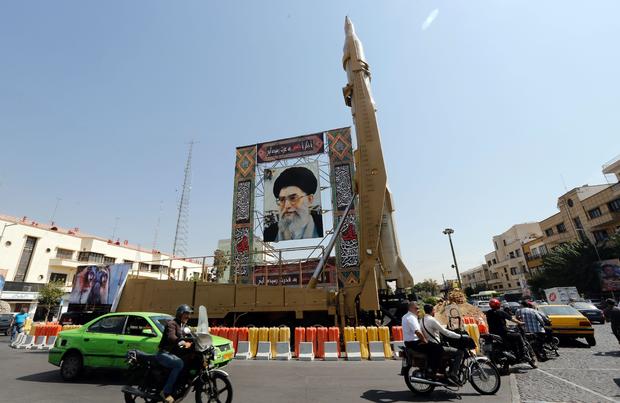/ CBS/AP

Washington — A Navy warship has seized a "significant cache" of suspected Iranian guided missile parts headed to rebels in Yemen, U.S. officials said Wednesday, marking the first time that such sophisticated components have been taken en route to the war there. A U.S. official confirmed the seizure to CBS News national security correspondent David Martin.
The seizure from a small boat by the U.S. Navy and a U.S. Coast Guard boarding team took place last Wednesday in the northern Arabian Sea, and the weapons have been linked to Iran.
Officials said the incident illustrates Iran's continuing efforts to smuggle weapons to Houthi rebels in Yemen, and news of it came as Secretary of State Mike Pompeo and Israeli Prime Minister Benjamin Netanyahu were meeting, with Iran as the main topic.
In a statement, Cmdr. Sean Robertson, a Pentagon spokesman, said a U.S. warship inspection discovered a cache of weapons and advanced missile components. He said, "An initial investigation indicates that these advanced missile components are of Iranian origin."
According to the U.S. officials who spoke to the AP, sailors aboard the USS Forrest Sherman noticed a small wooden boat that was not displaying a country flag. The Navy and Coast Guard personnel stopped, boarded the boat for inspection and found the weapons. The officials did not provide the exact number of missiles or parts but did describe it as a significant cache and said it was headed to Yemen.
The U.S. has consistently accused Iran of illegally smuggling arms to Houthi rebels battling the Yemeni government and has seized smaller and less sophisticated weapons in transit. Officials told the Associated Press that the missile parts found in this latest incident were more advanced than any others previously seized.
U.S. forces in the region
Since the spring, the Pentagon has beefed up its military strength in the region, adding about 14,000 troops, ships, aircraft and other assets in response to what officials said is a growing threat from Iran. Officials have been considering another increase of several thousand forces, which could include air, naval and ground troops, and weapons systems, but no decisions have been made.
Pentagon Press Secretary Alyssa Farah on Wednesday denied a report by the Wall Street Journal that the administration was considering sending as many as 14,000 more troops to the Middle East as a bulwark against Iranian aggression, but she did not refute discussions about some level of additional deployment.
To be clear, the reporting is wrong. The U.S. is not considering sending 14,000 additional troops to the Middle East.
— Alyssa Farah (@PentagonPresSec) December 5, 2019
Any decision by the White House to further increase the American troop presence in the Middle East is likely to draw scrutiny from lawmakers, given President Trump's frequently-expressed desire to extricate the U.S. from "endless wars" in the region.
Farah flagged one of her tweets denying the Wall Street Journal report on Wednesday to Republican Senator Josh Hawley from Missouri, who said in an earlier tweet that he looked forward to questioning American military leaders about any plans for a new deployment.
"After sending 14,000 already this year alone," Hawley said, "is the Pentagon preparing for a land war?"
Iran's missiles
Smuggling weapons into Yemen is a violation of an existing U.N. Security Council resolution against Iran.
Since President Trump's May 2018 decision to pull the U.S. unilaterally out of the 2015 international nuclear deal with Iran, the Islamic Republic has steadily increased its violations of the terms of that agreement. Tehran blames Washington for abandoning it first, and European countries for failing to keep it viable by finding a way around newly-imposed U.S. sanctions meant to choke off the country's vital oil revenues.
One of the stipulations of the nuclear deal calls on Iran to refrain from any work to develop new nuclear-capable missiles. While the agreement does not include an outright ban on such activity, it urges Tehran not to work on such weapons, and three European nations this week have accused Iran of violating that principle.
France, Germany and the United Kingdom said Wednesday that "Iran's developments of nuclear-capable ballistic missiles" were ongoing, and showed further non-compliance with the 2015 nuclear deal.
Ambassadors from the three European nations urged U.N. Secretary-General Antonio Guterres in a letter circulated Wednesday to inform the council in his next report that Iran's ballistic missile activity was "inconsistent" with the resolution.
The letter cites footage released on social media on April 22, 2019, of a previously unseen flight test of a new Shahab-3 medium-range ballistic missile variant "equipped with a maneuverable re-entry vehicle." It says: "The Shahab-3 booster used in the test is a Missile Technology Control Regime category-1 system and as such is technically capable of delivering a nuclear weapon."
Officials in the Trump administration also have said Iran is working to obtain nuclear-capable missiles, something the Iranians deny.
While President Trump withdrew from the nuclear agreement in May 2018, it is still supported by the five other parties - France, Britain, Russia and China, which are all veto-wielding Security Council members, and Germany, which is currently serving a two-year term on the council.
The Iranian government insists all its missile activities are legal and not nuclear-related.
